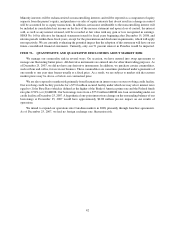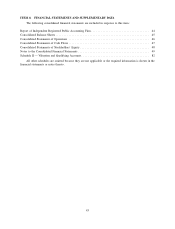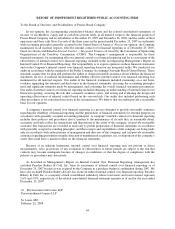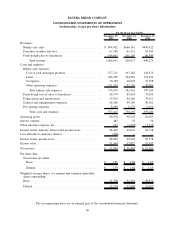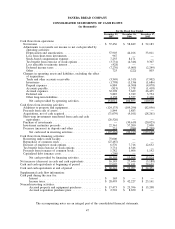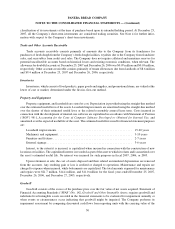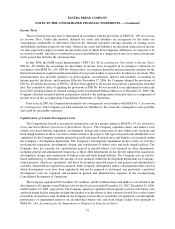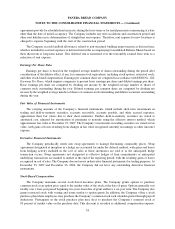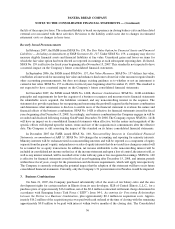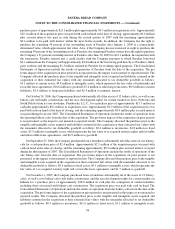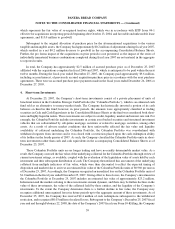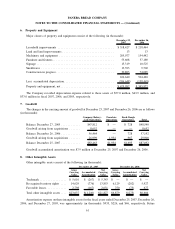Panera Bread 2007 Annual Report Download - page 62
Download and view the complete annual report
Please find page 62 of the 2007 Panera Bread annual report below. You can navigate through the pages in the report by either clicking on the pages listed below, or by using the keyword search tool below to find specific information within the annual report.Income Taxes
The provision for income taxes is determined in accordance with the provisions of SFAS No. 109, Accounting
for Income Taxes. Under this method, deferred tax assets and liabilities are recognized for the future tax
consequences attributable to differences between the financial statement carrying amounts of existing assets
and liabilities and their respective tax basis. Deferred tax assets and liabilities are measured using enacted income
tax rates expected to apply to taxable income in the years in which those temporary differences are expected to be
recovered or settled. Any effect on deferred tax assets and liabilities of a change in tax rates is recognized in income
in the period that includes the enactment date.
In July 2006, the FASB issued Interpretation (“FIN”) No. 48, Accounting for Uncertainty in Income Taxes.
FIN No. 48 clarifies the accounting for uncertainty in income taxes recognized in an enterprise’s financials in
accordance with SFAS No. 109. FIN No. 48 prescribes a recognition threshold and measurement attribute for the
financial statement recognition and measurement of a tax position taken or expected to be taken in a tax return. This
pronouncement also provides guidance on derecognition, classification, interest and penalties, accounting in
interim periods, disclosure, and transition. Effective December 27, 2006, the Company adopted the provisions of
FIN No. 48 and the provisions of FIN No. 48 have been applied to all income tax positions commencing from that
date. The cumulative effect of applying the provisions of FIN No. 48 was recorded as an adjustment to reduce the
fiscal 2007 opening balance of retained earnings in the Consolidated Balance Sheets as of December 27, 2006. The
Company classifies estimated interest and penalties related to the underpayment of income taxes as a component of
income taxes in the accompanying Consolidated Statements of Operations.
Prior to fiscal 2007, the Company determined its tax contingencies in accordance with SFAS No. 5, Accounting
for Contingencies. The Company recorded estimated tax liabilities to the extent the contingencies were probable
and could be reasonably estimated.
Capitalization of Certain Development Costs
The Company has elected to account for construction costs in a manner similar to SFAS No. 67, Accounting for
Costs and Initial Rental Operations of Real Estate Projects. The Company capitalizes direct and indirect costs
clearly associated with the acquisition, development, design, and construction of new bakery-cafe locations and
fresh dough facilities as these costs have a future benefit to the projects. The types of specifically identifiable costs
capitalized by the Company includes primarily payroll and payroll related taxes and benefit costs incurred within
the Company’s development department. The Company’s development department focuses solely on activities
involving the acquisition, development, design, and construction of bakery-cafes and fresh dough facilities. The
Company does not consider for capitalization payroll or payroll-related costs incurred in other departments,
including general and administrative functions, as these other departments do not directly support the acquisition,
development, design, and construction of bakery-cafes and fresh dough facilities. The Company uses an activity-
based methodology to determine the amount of costs incurred within the development department for Company-
owned projects, which are capitalized, and those for franchise-operated projects and general and administrative
activities, which both are expensed as incurred. If the Company subsequently makes a determination that a site for
which development costs have been capitalized will not be acquired or developed, any previously capitalized
development costs are expensed and included in general and administrative expenses in the accompanying
Consolidated Statements of Operations.
The Company capitalized $10.2 million, $9.1 million, and $7.0 million direct and indirect costs related to the
development of Company-owned bakery-cafes for the fiscal years ended December 25, 2007, December 26, 2006,
and December 27, 2005, respectively. The Company amortizes capitalized development costs for each bakery-cafe
and fresh dough facility using the straight-line method over the shorter of their estimated useful lives or the related
reasonably assured lease term. In addition, the Company assesses the recoverability of capitalized costs through the
performance of impairment analyses on an individual bakery-cafe and fresh dough facility basis pursuant to
SFAS No. 144, Accounting for the Impairment or Disposal of Long-Lived Assets.
52
PANERA BREAD COMPANY
NOTES TO THE CONSOLIDATED FINANCIAL STATEMENTS — (Continued)


